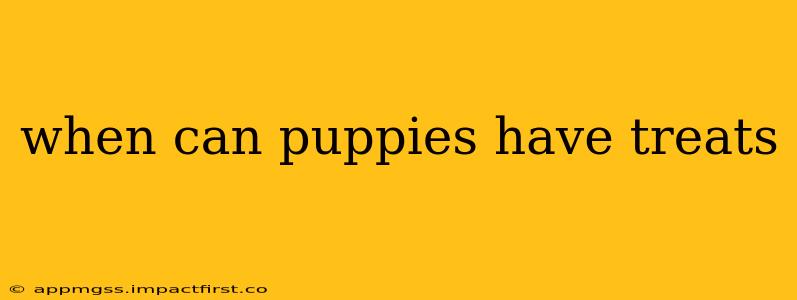Bringing home a new puppy is an exciting time! From playful nips to clumsy tumbles, every moment is filled with joy. But as responsible pet owners, we also need to understand the crucial aspects of their health and development, including when and how to introduce treats into their diet. Giving treats too early can lead to digestive upset and other problems, while delaying it could miss opportunities for training and bonding. This guide will clarify when and how to safely introduce treats to your furry friend.
What Age Can Puppies Start Eating Treats?
Generally, puppies can begin eating soft, easily digestible treats around 4 weeks old. However, this is a broad guideline, and the best time depends on several factors, including:
- Breed: Smaller breeds might mature faster than larger breeds. A tiny Chihuahua might be ready for small, soft treats sooner than a Great Dane puppy.
- Individual Development: Some puppies are simply more developed than others at the same age. Observe your puppy's overall health and development. Are they eating their puppy food readily? Do they have a healthy bowel movement schedule?
- Veterinarian Advice: The most reliable source of information is always your veterinarian. They can assess your puppy's specific needs and provide personalized recommendations.
Before 4 weeks, your puppy's primary source of nutrition should be its mother's milk. If the puppy is orphaned, your veterinarian will guide you on appropriate puppy milk replacer and the timing of introducing solid foods.
What Kind of Treats Are Safe for Young Puppies?
When you do introduce treats, choose small, soft, easily digestible options. Avoid anything hard, crunchy, or that could be a choking hazard. Excellent choices include:
- Plain cooked chicken or beef: Ensure it's thoroughly cooked and finely chopped or shredded.
- Plain cooked sweet potato or carrot: Soft, cooked vegetables are good sources of nutrients.
- Small pieces of plain yogurt (unsweetened): A tiny amount of plain yogurt can provide beneficial probiotics (always check with your vet first).
- Puppy-specific treats: Many commercially available puppy treats are formulated to be gentle on their digestive systems. Look for options with simple, recognizable ingredients.
Absolutely Avoid:
- Chocolate: This is toxic to dogs and can be fatal.
- Grapes and raisins: These can cause kidney failure in dogs.
- Onions and garlic: These are toxic to dogs.
- Xylitol (artificial sweetener): This can cause a dangerous drop in blood sugar.
- Bones (raw or cooked): These can splinter and cause internal injuries.
How Many Treats Should I Give My Puppy?
Treats should only comprise a small percentage of your puppy's total daily caloric intake. Overfeeding treats can lead to obesity and other health problems. Start with tiny amounts, using treats primarily for training and positive reinforcement. As your puppy gets older, you can gradually increase the amount, but always keep it moderate.
How Often Should I Give My Puppy Treats?
Frequency depends on the type and amount of treats. If it is a small, soft treat used during training, offering one or two during a session is perfectly fine. Avoid overdoing it. The goal is to use treats to reward good behavior, not to fill your puppy up.
Can I Give My Puppy Human Food as Treats?
While some human foods can be safe in moderation (as discussed above), it's generally best to avoid giving your puppy scraps from your table. Human food often contains seasonings, preservatives, and other ingredients that are not good for your puppy's digestion and overall health. Sticking to specifically formulated puppy treats or the healthy options listed above ensures you are providing a safe and nutritious supplemental food source.
By following these guidelines and consulting your veterinarian, you can ensure your puppy receives the proper nutrition and benefits from treats in a healthy, safe, and enjoyable way! Remember, responsible pet ownership involves careful planning and attention to your puppy’s needs.
